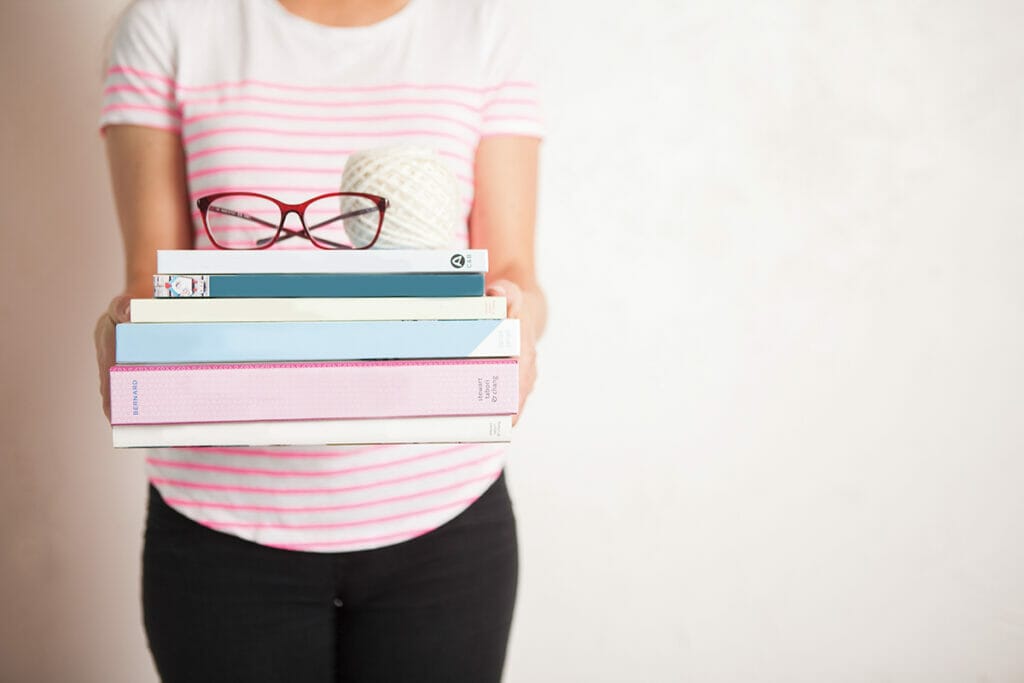Summer is the best time of year for reading, but that doesn’t mean you need to put your knitting aside! We asked two Knit Picks team members who love to knit and read at the same time to share how they manage both and to share their best tips. Reading and knitting at the same time might sound a little unusual, but once you find your favorite method to keep your text visible and the right project to knit without looking at too much, it’s easier than you might imagine!

When it comes to multitasking, most knitters I know tend to watch movies or catch up on tv shows while working on their projects. While I do that too, I do love to get lost in a good book. Audiobooks will scratch that itch occasionally, but I have always preferred reading the words – I’m visual learner and retain it much better when I can read them! So I had to work out a system for myself so I can do both of my favorite hobbies at the same time.
Mainly these days I use an eReader. I have, with varying levels of success, read physical books – hard covers that open flat work the best; I’ve also used cookbook holders to prop open books in the past. But that just wasn’t as convenient, and I would lose my either lose place completely (in both the book and my knitting project) from it falling over or fumble around trying to turn the pages.
My current eReader cover has a nice and convenient kick stand on the back so it’ll stand up on it own and is small enough to sit on the arm of my couch. I’ll usually pick a project that I don’t have to look at my hands a lot (so for me, I’m not able to crochet & read yet) and one where I don’t have to constantly look at a chart. Then I just read! I just need to tap the page every so often to “turn” the page, but it’s such a quick movement, I don’t lose my place.
— Stacey

I’m a low-tech reader and knitter. I originally started to read and knit at the same time when I was in college and developed my method using items I had on hand and physical books from the campus bookstore. I sit at a table, simply lay my book flat on the surface, and weigh it open using an old Swingline stapler or a heavy ruler. I periodically do have to stop knitting to move my weight and turn the page, which influences my project choices if I know I’d like to read and knit, but it’s not too inconvenient to deter me. Because I have to pick up and put down my knitting a lot, I stick to smaller, single color knits, so there’s less yarn and knitting to get tangled.
To read and knit at the same time, the most important skill is being able to knit by touch. To master that skill, I started with knitting simple stockinette beanies in the round. I got used to the feel of finding the next stitch to knit without looking or splitting the stitch, and after I had that down, I began practicing 1×1 rib by touch, getting to know the different feel of knit and purl stitches under my left hand, so I knew what stitch to work next without looking. Once you can feel the difference on your needle between knits and purls without looking, that opens up many basic stitch patterns for easy hats, socks, or sweater pieces.
Plain vanilla knits will always be best for knitting and reading, but even those require a little shaping or some extra details from time to time, and for those situations I recommend heavy use of stitch markers. With markers everywhere I may need to do something other than a knit or purl, I can happily knit along while reading until I hit a marker that tells me to look away from my book for a moment. I can quickly check if I need to do anything this round, work my shaping if necessary, and then get back to my reading and plain stitches!
— Andi










